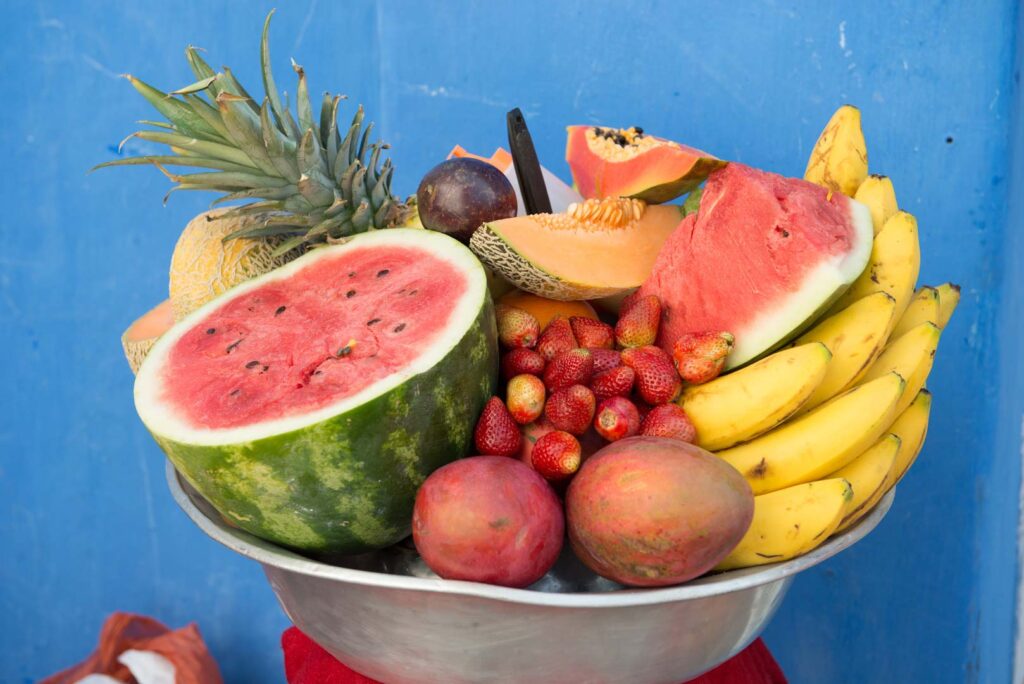Cartagena, Colombia, is a city that awakens the senses. From the moment you step onto its cobblestone streets, you are enveloped by a symphony of colors, aromas, and sounds. The Caribbean breeze carries the scent of salt and ripe fruit, while street vendors call out, offering an array of exotic flavors that seem almost too vibrant to be real. This is a city where history and culture blend seamlessly, and nothing reflects this better than its dazzling selection of tropical fruits.
If you’re a traveler with a passion for food, exploring Cartagena’s fruit markets is a must. These fruits are more than just delicious; they tell the story of the land, the people, and the traditions that have shaped this coastal paradise. So, grab a fresh coconut, let the juice run down your fingers, and embark on a flavorful adventure through Cartagena’s tropical bounty.
Mango: The King of Sweet and Sour
Mango is a fruit that needs no introduction, but in Cartagena, it takes on new dimensions. Here, you can enjoy it in multiple ways—sliced and sprinkled with salt, lime, and pepper for a tangy kick, or blended into a thick, refreshing juice. During mango season, street vendors push wooden carts filled with golden and green mangoes, their fragrance lingering in the air. Try a ‘mango biche,’ an unripe, crunchy version served with lemon and salt—an explosion of tartness that wakes up your taste buds.
Lulo: The Citrus Mystery
Lulo, a fruit that remains largely unknown outside of South America, is one of Cartagena’s hidden treasures. It looks like a small orange tomato, but its flavor is a tantalizing mix of citrus and pineapple, with a hint of tartness. Lulo is most commonly enjoyed as a juice—‘lulada’—a frothy, icy drink that is both refreshing and energizing in the sweltering Caribbean heat. One sip, and you’ll understand why locals swear by its rejuvenating properties.
Passion Fruit: The Tart and Sweet Delight
Known as ‘maracuyá’ in Spanish, passion fruit is a true star in Cartagena’s tropical repertoire. Its wrinkled yellow or purple skin hides a pulp bursting with intense, aromatic flavor. Whether eaten fresh with a spoon, blended into a smoothie, or mixed into cocktails, maracuyá is a sensory delight. Locals often combine it with condensed milk for a creamy, tangy dessert that is simply irresistible.
Guanábana: The Creamy Dream
Guanábana, or soursop, is a fruit that defies expectations. Its spiky green exterior gives way to soft, white flesh that tastes like a combination of banana, pineapple, and coconut. This fruit is a staple in Cartagena’s juice bars, where it is blended into thick, milky drinks that soothe and refresh. Some say it even has medicinal properties, but one thing is certain: a glass of guanábana juice is pure tropical indulgence.
Mamoncillo: The Tiny Flavor Bomb
At first glance, mamoncillo (or Spanish lime) looks like an unassuming green marble. But crack open its thin shell, and you’ll find a juicy, sweet-and-sour pulp that’s impossible to resist. Eating mamoncillo is an experience in itself—pop one in your mouth, suck on the pulp, and savor the burst of tangy sweetness before discarding the large seed. It’s the perfect street snack, sold in bunches from woven baskets by local vendors.
Pitahaya: The Exotic Dragon Fruit
Cartagena’s version of dragon fruit, or pitahaya, is a stunning yellow fruit with a soft, jelly-like interior speckled with black seeds. Its mild, honeyed taste and crisp texture make it a favorite among travelers looking for a light, refreshing treat. Plus, it’s packed with antioxidants and hydration—ideal for a day of exploring the city’s vibrant streets.
Papaya: The Tropical Classic
Papaya is a staple fruit in Cartagena, commonly found in breakfast spreads alongside fresh cheese and arepas. Its bright orange flesh is both sweet and buttery, often eaten with a drizzle of lime juice to enhance its natural flavor. Whether sliced, blended into a juice, or mixed into fruit salads, papaya is a taste of the tropics you won’t forget.
Corozo: The Local Superberry
Corozo, a small, dark-red fruit, might not be as well-known as other tropical fruits, but it holds a special place in Cartagena’s culinary culture. It’s often transformed into a rich, tangy juice that is both refreshing and slightly tart. During festivals and celebrations, corozo juice is a staple, offering a deep, berry-like flavor reminiscent of cranberries and cherries.
Chontaduro: The Energy Booster
Often called the ‘peach palm fruit,’ chontaduro is a unique delicacy in Cartagena. With a starchy, dense texture and a slightly nutty taste, it is often eaten with a sprinkle of salt and honey. Street vendors sell it in small bags, promising energy and vitality—some even say it’s an aphrodisiac. Whether or not that’s true, chontaduro is definitely a fruit that leaves an impression.
Exploring Cartagena’s Fruit Markets
For the ultimate fruit experience, visit Cartagena’s bustling markets. The Mercado de Bazurto is a chaotic yet fascinating place where you can find every tropical fruit imaginable. Vendors enthusiastically offer samples, slicing open fruits with practiced ease. If you prefer a more curated experience, head to Plaza de la Trinidad or walk through the Old City, where fruit vendors line the streets with colorful displays.
Tasting Cartagena, One Fruit at a Time
Tropical fruits are more than just a delicious part of Cartagena’s culinary scene—they are a gateway to the city’s soul. Each bite carries the warmth of the Caribbean sun, the richness of the land, and the stories of the people who cultivate them. Whether you’re sipping a passion fruit cocktail at a beachfront bar or enjoying a fresh mango under the shade of a colonial balcony, these fruits connect you to the essence of Cartagena.
So, next time you find yourself wandering through this magical city, take a moment to embrace its flavors. Taste the tartness of lulo, the creaminess of guanábana, and the tangy sweetness of mamoncillo. Let Cartagena’s tropical fruits guide you through an unforgettable culinary adventure—one juicy, vibrant bite at a time.

